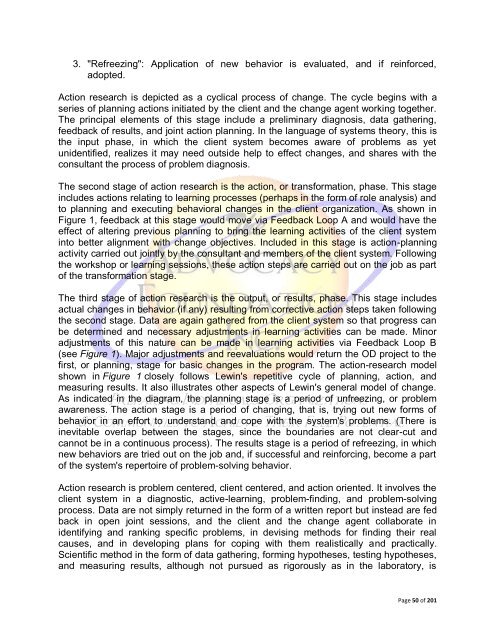ComeUnity CAPACITY BUILDING
ComeUnity CAPACITY BUILDING
ComeUnity CAPACITY BUILDING
You also want an ePaper? Increase the reach of your titles
YUMPU automatically turns print PDFs into web optimized ePapers that Google loves.
3. "Refreezing": Application of new behavior is evaluated, and if reinforced,<br />
adopted.<br />
Action research is depicted as a cyclical process of change. The cycle begins with a<br />
series of planning actions initiated by the client and the change agent working together.<br />
The principal elements of this stage include a preliminary diagnosis, data gathering,<br />
feedback of results, and joint action planning. In the language of systems theory, this is<br />
the input phase, in which the client system becomes aware of problems as yet<br />
unidentified, realizes it may need outside help to effect changes, and shares with the<br />
consultant the process of problem diagnosis.<br />
The second stage of action research is the action, or transformation, phase. This stage<br />
includes actions relating to learning processes (perhaps in the form of role analysis) and<br />
to planning and executing behavioral changes in the client organization. As shown in<br />
Figure 1, feedback at this stage would move via Feedback Loop A and would have the<br />
effect of altering previous planning to bring the learning activities of the client system<br />
into better alignment with change objectives. Included in this stage is action-planning<br />
activity carried out jointly by the consultant and members of the client system. Following<br />
the workshop or learning sessions, these action steps are carried out on the job as part<br />
of the transformation stage.<br />
The third stage of action research is the output, or results, phase. This stage includes<br />
actual changes in behavior (if any) resulting from corrective action steps taken following<br />
the second stage. Data are again gathered from the client system so that progress can<br />
be determined and necessary adjustments in learning activities can be made. Minor<br />
adjustments of this nature can be made in learning activities via Feedback Loop B<br />
(see Figure 1). Major adjustments and reevaluations would return the OD project to the<br />
first, or planning, stage for basic changes in the program. The action-research model<br />
shown in Figure 1 closely follows Lewin's repetitive cycle of planning, action, and<br />
measuring results. It also illustrates other aspects of Lewin's general model of change.<br />
As indicated in the diagram, the planning stage is a period of unfreezing, or problem<br />
awareness. The action stage is a period of changing, that is, trying out new forms of<br />
behavior in an effort to understand and cope with the system's problems. (There is<br />
inevitable overlap between the stages, since the boundaries are not clear-cut and<br />
cannot be in a continuous process). The results stage is a period of refreezing, in which<br />
new behaviors are tried out on the job and, if successful and reinforcing, become a part<br />
of the system's repertoire of problem-solving behavior.<br />
Action research is problem centered, client centered, and action oriented. It involves the<br />
client system in a diagnostic, active-learning, problem-finding, and problem-solving<br />
process. Data are not simply returned in the form of a written report but instead are fed<br />
back in open joint sessions, and the client and the change agent collaborate in<br />
identifying and ranking specific problems, in devising methods for finding their real<br />
causes, and in developing plans for coping with them realistically and practically.<br />
Scientific method in the form of data gathering, forming hypotheses, testing hypotheses,<br />
and measuring results, although not pursued as rigorously as in the laboratory, is<br />
Page 50 of 201

















